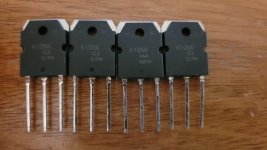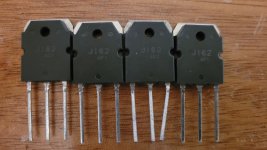Hi umut1001,
There are plenty of really good amplifiers you can build with them. You want compliments of course, and sell the rest. Don't be greedy.
Everyone has a favorite amplifier design type. I have more than one, but others may be stuck on one like a religion. Some of the kits here are excellent, and community builds.
Just check the ratings against the original part in a design. The supply voltage will be determined by the VCE of the lowest rated part in the output stage. Ignore the VCB rating, which is sometimes higher. Also be mindful of the max current rating (IC). I haven't look them up, but I would do as I suggested to you.
-Chris
There are plenty of really good amplifiers you can build with them. You want compliments of course, and sell the rest. Don't be greedy.
Everyone has a favorite amplifier design type. I have more than one, but others may be stuck on one like a religion. Some of the kits here are excellent, and community builds.
Just check the ratings against the original part in a design. The supply voltage will be determined by the VCE of the lowest rated part in the output stage. Ignore the VCB rating, which is sometimes higher. Also be mindful of the max current rating (IC). I haven't look them up, but I would do as I suggested to you.
-Chris
Even the old Symasym is a great performer. Too simple will not perform as well as a design "just complicated enough". The extra parts generally increase circuit gain, increase linearity and increase CMRR. Circuit gain translates into higher feedback, and that is always good no matter what some people will say. That's as long as the basic design is good that is. Higher CMRR means that the distortion cancellation happens accurately. This makes a big difference.
Board layout has a great impact on the performance as well, even with the same exact schematic.
Anyway, this is a thread on parts and if they are real or not. You should move this line of discussion into it's own thread.
-Chris
Board layout has a great impact on the performance as well, even with the same exact schematic.
Anyway, this is a thread on parts and if they are real or not. You should move this line of discussion into it's own thread.
-Chris
Recently I took a crack at a new pcb for the power amp (AWH-048) used in a Pioneer SX-1250.Board layout has a great impact on the performance as well, even with the same exact schematic.
I did not change the design toplogy, but I changed the physical layout to use a different heatsink that has the pre-drivers(KSA1381/C3501), drivers(MJE15032,33) and one of the thermal sensing bjts on it for the bias spreader. Replaced the old STV-4H diode stacks with a different bias spreader design as used by Bob Cordell in the BC-1 amp design. The OPS are remote on the big heatsinks along with another thermal sensing bjt, I used MJ21195/6 since I do not have the original devices. This part recipe has been used on the original. I do not have a sx-1250 but I have the transformer and have reproduced the PS's pcbs as well, so its pretty close to an original test setup as I can get right now.
Rev A0: I layed it out as I thought fit, not really following the way Pioneer did it. I powered up using a bench +/-50V supply at first, I noticed it was oscillating and was puzzled. Once the regulated supply for the front end gets up to spec +/-65V it runs fine, with out oscillation, slight peaking on a 10KHz sq wave. I did not measue THD initially because I was off chasing the oscillation issue.
I once I had the setup ruuning into load, I could get 1KHz THD, close to clipping into 8 ohm load around -92dB
I got an original Pioneer AWR-048, on loan, using the same prt recipe and test setup, to compare against, it measures and performs about the same, as my rev A0.
Rev's A1,A2: added a constant current source for the tail current instead of a resistor. This improved the low V oscillation issue. I added this flying wire mod on A0 to prove it worked. What I thought were layout improvements actually cause the THD numbers to be >10dB higher. Since I did a number of changes, I am now a bit at a loss as to what exactly was changed layout wise to cause the increase in THD. Anyone want to take a look and offer a reason.
If so I'll start an new thread and post the layouts etc.
I could just stick with rev A0 and call it a day too, but knowing what caused the increase is a learning experience.
this ebay offer show a version with logo:I miss the Hitachi logo.
https://www.ebay.ca/itm/203387193374
and here Hitachi vs. Renesas
https://ldsound.info/2sk1058-2sj162-lateral-pair-renesas/2sk1058-2sj162-ldsound-ru-10/
Because RENESAS don't offer any successor - go to
https://www.renesas.com/us/en/produ...standard-pkg-type=TO-220,TO-220F,TO-3P,TO-3PF
for me the main question is actually, what is the best replacement by currently available Power MOSFET's.
check also out this thread:
https://www.diyaudio.com/community/threads/renesas-2sk1058-2sj162-power-mosfet.348036/page-2
They look good to me.Hi Guys,
I purchased some 2Sk1058 and 2SJ162 mosfets on clearance from a local brick and mortar store here in New Zealand.
Are these the genuine article?
Worth at least 5 bars of gold press latinum if they are real. They LOOK very real - exactly like ON normally does from that vintage (I have plenty to compare with and they are spot on). Nothing throws a red flag other than the fact that those types may have been discontinued in 2000/2001. I‘m not sure exactly WHEN they were. Possible they were a special run for a high end manufacturer (who might otherwise have used a house number) - getting them long after the rest of us couldn‘t. They have been known to do that for makers like Krell - there is precedent for that.
I wouldn’t do any destructive testing because they are rare. If they are fakes, the maker wouldn’t bother putting anything worth a damn in there. Just look at basic characterstics and look for signs of fakes - like a very high Vbe, excessive low current hFE, or input (base emitter) capacitance under about 4000 pF. If it “looks” bigger than a 2N3055 it probably is.
I wouldn’t do any destructive testing because they are rare. If they are fakes, the maker wouldn’t bother putting anything worth a damn in there. Just look at basic characterstics and look for signs of fakes - like a very high Vbe, excessive low current hFE, or input (base emitter) capacitance under about 4000 pF. If it “looks” bigger than a 2N3055 it probably is.
- Home
- Design & Build
- Parts
- My Transistors, original or copy?

